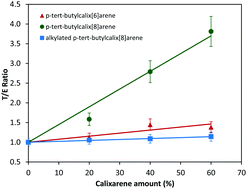Calixarene–polymer hybrid film for selective detection of hydrocarbons in water
Abstract
One major issue that precludes the application of chemical sensors for the analysis and quantification of dissolved hydrocarbon contaminants in environmental waters is interference from similar types of organic molecules. Polymer-based sensing films are used extensively to interact with certain classes of organic compounds; however, these materials have not been able to achieve sufficient selectivity when analysing complex multicomponent hydrocarbon mixtures in real aquatic systems. Polymer composite materials are an alternative approach towards improving the selectivity and analytical response of sensors for hydrocarbons. In this study, calixarene–polyisobutylene composite films were synthesised via a solvent casting method and the structural and sorption properties were investigated using infrared spectroscopy. The type and amount of calixarene in polyisobutylene was varied and it was shown that the calixarene content in the film plays a significant role on the hydrocarbon sorption mechanism. Scanning electron microscope and optical microscope studies revealed the formation of calixarene microparticles within the polymer film and that this may be responsible for the observed differences in hydrocarbon sensitivity. We demonstrate using toluene and ethylbenzene that the molecular selectivity of polymer films can be tailored by adjusting the calixarene type and concentration.



 Please wait while we load your content...
Please wait while we load your content...